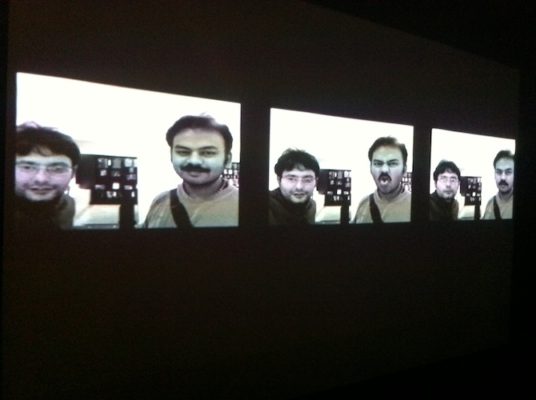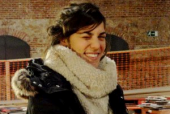Search
To search for an exact match, type the word or phrase you want in quotation marks.
A*DESK has been offering since 2002 contents about criticism and contemporary art. A*DESK has become consolidated thanks to all those who have believed in the project, all those who have followed us, debating, participating and collaborating. Many people have collaborated with A*DESK, and continue to do so. Their efforts, knowledge and belief in the project are what make it grow internationally. At A*DESK we have also generated work for over one hundred professionals in culture, from small collaborations with reviews and classes, to more prolonged and intense collaborations.
At A*DESK we believe in the need for free and universal access to culture and knowledge. We want to carry on being independent, remaining open to more ideas and opinions. If you believe in A*DESK, we need your backing to be able to continue. You can now participate in the project by supporting it. You can choose how much you want to contribute to the project.
You can decide how much you want to bring to the project.

Either it was done on purpose or it was just a stroke of luck. Arts Santa Mònica and Foto Colectania have joined forces to present two exhibitions about post-photography, both curated by Joan Fontcuberta (the first, along with Clément Chéroux, Erik Kessels, Martin Parr and Joachim Schmid). Pre-planned or not, Barcelona pays homage to the prizewinning photographer, as we also find him at Àngels Barcelona, as recounted by Avelino Sala just a few days ago.
The interest in From Here On, at Arts Santa Mònica until 13 April, lies in what the curatorial team focuses on (with an almost blinding light): the unquestionable and highly entropic transformation, exerted by the appearance and evolution of internet and mobile phones in the ambit of recording image and sound. In the case of Obra-Col·lecció (El artista como coleccionista), at Foto Colectania until 25 May, the crux lies in how Fontcuberta indicates the crossovers occurring between professions and roles in the art world that in bygone days were totally separate. Fontcuberta argues that they are different types of collecting: the classical, amasses; the artist who collects “repositions”, proposing new semantics and generating new narratives through the arrangement of pre-existing images. Post-photography approaches images from a different place as: firstly, the origin of the photographs (who or what captures the image) can be unknown or directly irrelevant. Secondly, the media from where the images are taken and/or reproduced are mere supports and don’t have the aura of devotion that cameras or what could be called ‘classical’ photographic prints enjoyed.
The show in Foto Colectania is small and coherent. It brings together 10 artists, all collectors of images who generate narratives of different sorts. The pieces by Joachim Schmidt, Penelope Umbrico, Hans Eijkelboom and Eric Tabuchi, on the ground floor, are a perfect summary of the exhibition. On the floor above, Martin Parr’s ‘Painted Photos’ are surprising and Erik Kessels’ entertains, with his hilarious ‘Almost Every Picture #9’. We can also find a thoughtful (and prize-winning) video by Jean-Gabriel Périot entitled ‘Dies Irae’ (2005) and pieces by Ève Cadieux, Emilio Chapela and Richard Simpkin.
What we discover in Arts Santa Mónica is on the other hand an exhibition that might initially appear disjointed (though I’m not sure if it’s just a personal issue with the space), but which still makes sense. The argument is clarified in a large manifesto on the lower flower and is even repeated on the stairwary, between the treads: Internet and the era of mobile phones have been the medial, technological triggers, that have enabled an exponential propagation of photographic registers. Ideas proliferate: if truth was ever unitary, through multiple captures it becomes infallibly fragmentary.
Corinne Viennet superimposes thousands of photographs of tourist monuments found on the Internet. These photographs, almost always taken from the same angle, interweave and generate an image that is both one and all, a product perhaps of these shared impulses, common denominators of the human race doing the “tourist trail”. Google Maps is the source of Jon Rafman’s piece (with its Street View, an application that enables the user to see a real image of the street being sought). As it is for Aram Bartholl and his enormous “A”s. Herman Zschiegner plays with the idea of the infinite copy through the triangle Google- Walker Evans- Sherrie Levine, presenting multiple versions of Allie Mae Burroughs, only distinguishable by their URL origin and the ratio of their pixels. Jens Sudheim makes a photograph album along with his collaborator, Reuss, with the traveller posing in front of different public cameras and webcams in order to record his journey across five continents. Tony Churnside and “The get out clause” even manage to make a whole video-clip thanks to the shots taken by security cameras in different places in the United Kingdom. The Belgian collective Leo Gabin proposes a video that shows how various girls (there are no doubt more) set up their webcam and shimmy their hips in front it, for the world to see, from their domestic context. Willem Popelier makes use of the photographs registered by clients (and accessible for those who arrive afterwards) on the hard drives of computers in a computer shop. Laia Abril re-photographs photographs from blogs and webs of a community of anorexics. Nancy Bean exhibits a series of images from new angles (the origin of this curious perspective lies with her cat and collaborator, Christian Allen). Penélope Umbrico collects coincidences, and ultimately questions the over abundance of certain images (here, mirrors with reflections and flashes; in Foto Colectania, sunsets). The works of Andreas Schmidt (RGB), and Adrian Sauer also talk of abundance (and colour). Aarsman and Bohr explore the relation with the object and reiteration; as Frank Schallmaier does perhaps with his collection of penises, though with a different aim. Humour sparkles in the work of Thomas Mailaender and James Howard and all this to the cackling of some (real) chickens. Roc Herms tackles the online/offline world that it’s our lot to live; and in this string of highlights (not ordered by importance) one couldn’t forget the 3.000 phrases that begin with “The photograph is…” by Misha Hemmer.
In both shows there are “pieces” where the spatial-temporal coincidence of the “photographer” (or selector) and the photographed object doesn’t arise. Apart from searching the Internet, private collections acquired in flea markets are also modified, or worked with directly without any form of modification, so when’s the post-author debate?


Marina spent the first two years of her life without saying anything: they told her parents that she was internalizing. And even though it’s a while now since she learnt to talk, she still needs to internalize. To then shake things up, question, order, disorder and celebrate. She finds politics in many places and has a special interest in all that’s subaltern, in the “commons”, and in the points where all this has an impact on creative expression.
"A desk is a dangerous place from which to watch the world" (John Le Carré)